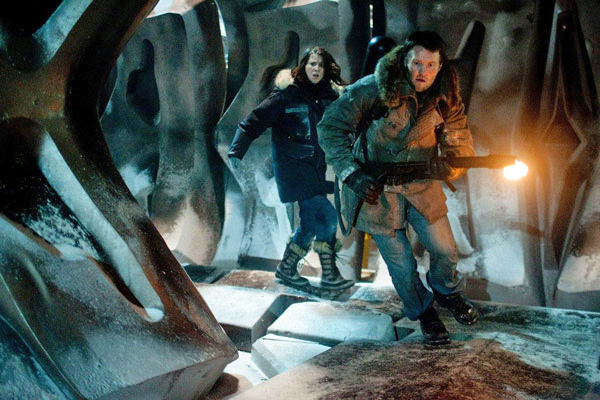Q. In your review of “Independence Day,” referring to the gigantic alien space craft, you write: “an object that size in near-Earth orbit might be expected to cause tidal waves.” Tidal waves, or tsunamis, are caused by sudden earth movement, not extraterrestrial objects. However, a craft one-fourth the mass of the moon, if at the same distance as the moon, would result in tides (not tidal waves) approximately 25% above normal–not fun but tolerable. If the mother ship were located one-half the distance of the moon, tidal influence of the ship would be equal to that of the moon. BUT, its orbital speed would be substantially faster, resulting in wild tides. The closer the object, the worse the effect. If the object were in close earth orbit, it wouldn’t need “death rays” to destroy cities; since most major cities are seaports, they would be ravaged by wild tides. I suspect this is what you meant and it is a excellent point. (Richard George, San Jacinto, Ca.)
A. That is what I meant and it is an excellent point.
Q. Do you think Burt Reynolds learned something from his hairpiece in “Striptease?” I thought it looked good on him. “Mr. Reynolds,” his assistant should have said one day on the set, “Look carefully in the mirror. Notice that the wig you’re now wearing (a) is colored to realistically jibe with your age, (b) is sized to fit your scalp, and most importantly, (c) is (italics) not intended to give you the hairline and thickness of Van Cliburn at age 18. And though it did require over half an hour to apply it to your scalp, at least it doesn’t look as though it came with a chin strap. In conclusion, sir, I hope that you bear these things in mind when you shop for your new hairpiece.” (Andy Ihnatko, Westwood, Mass.)
A. I am wondering if there is something seriously wrong with a man who attends “Striptease” and spends his time evaluating Burt Reynolds’ hairpiece.
Q. What was the first film to use the director’s name in the opening credits–for example, “A film by Robert Altman?” (Bert Schneider, Tucson, Ariz.)
A. The Directors’ Guild of America is stuck for an answer. David J. Korduner, its associate general counsel, told me: “I asked around the office and got assorted answers, as follows: (1) George Sidney, the distinguished director, thinks it was sometime in the 1960s, but is not sure. (2) Frank Capra had a possessive credit on ‘Frank Capra’s Mr. Smith Goes to Washington’ in 1939. (3) Norman Jewison might have had one in ‘In the Heat of the Night’ in 1967. (4) ‘Birth of a Nation,’ or one of the Chaplin films. (5) European directors a long time ago, like Abel Gance on ‘Napoleon.’ (6) Some French director like Francois Truffaut.”
Q. Re your doubts about the plausibility of the “rail guns” that shoot bullets at almost the speed of light, in Arnold Schwarzenegger’s “Eraser.” My cousin was one of the developers of the rail gun at the University of Texas in the ’80’s. It actually, in theory, does fire at the speed of light, because a man-made lightning bolt propels the object. There is no recoil, because there is no explosion in your typical gunpowder fashion. It’s being developed in a project called “Brilliant Pebbles,” as a Star Wars-type device which would actually shoot out numerous pieces of clay at this extremely high rate of speed into space to knock out incoming ballistic missiles. It’s one of those secret projects the government is working on, which is not so secret. (Drew Deiches, Orlando, Fla.)
A. At least not as long as your cousin blabs everything to you.
Q. One of the burgeoning trends is the rise of the 20-plus screen megaplex. By the end of 1997, there will be at least 120 screens in only five locations in Orange County. The big selling point is supposed to be that they can show the blockbusters and still have screens left over for the smaller artsy films. Of course, summer rolls around and of the 20 screens, five are showing “Independence Day,” four are showing “Mission: Impossible,” four are showing “The Nutty Professor” and, well, you get the picture. The 20 screens gives them extra seats for the big money makers and Merchant-Ivory be damned. I think they’re reneging on their promise. (Paul McElligott, Lake Forest, CA)
A. Whenever any large corporate or civic organization announces a big project, they promise what they know they should be doing. Then they go right ahead and do exactly what they were doing before. We’re told state lotteries raise money for education, gambling casinos increase local employment, and movie monsterplexes provide more screens for independent, art and documentary films. That is why we have such fine schools, no unemployment, and so many challenging and intelligent movies.
Q. I read an interesting article by Gary Dretzka in the Chicago Tribune, about trailers of coming attractions. In his lead, he quotes several lines from a review by a “prominent national critic” that is framed on the wall of New Wave Entertainment’s offices in Hollywood. The review is of “Sister Act,” the 1992 Whoopi Goldberg movie, and concludes, “whoever edited the trailer has a much better idea of what’s good in this material than the man who directed the movie.” Any idea who the “prominent national critic” could be? (Charles Smith, Chicago).
A. Why, golly–it’s me! I wrote it in the Chicago Sun-Times, a newspaper published not a million miles from the Trib’s own Gothic bunker. I am sending the Tribune a free copy of my book “Roger Ebert’s Video Companion,” to aid them in researching the sources of brilliant quotes in movie articles.











